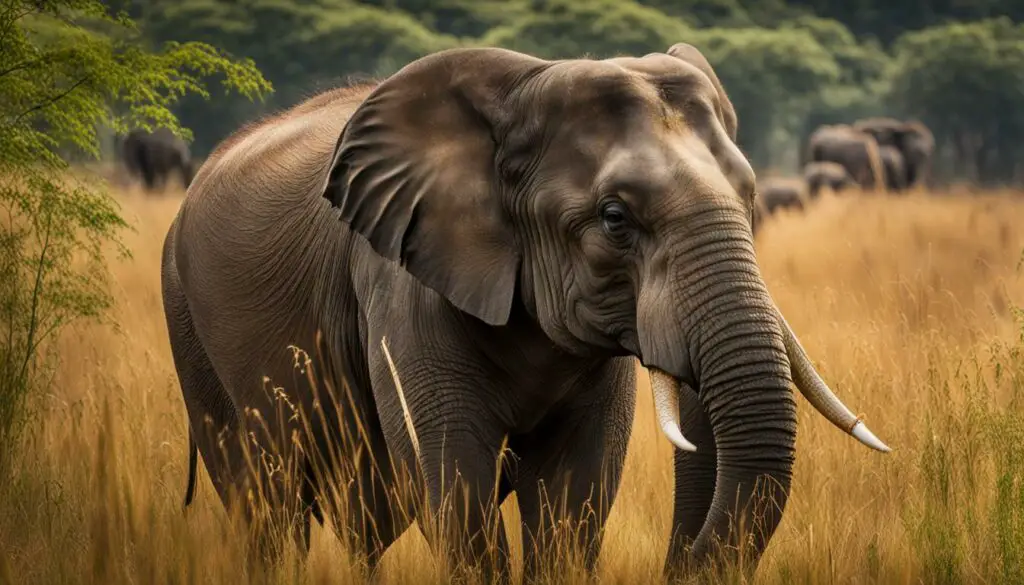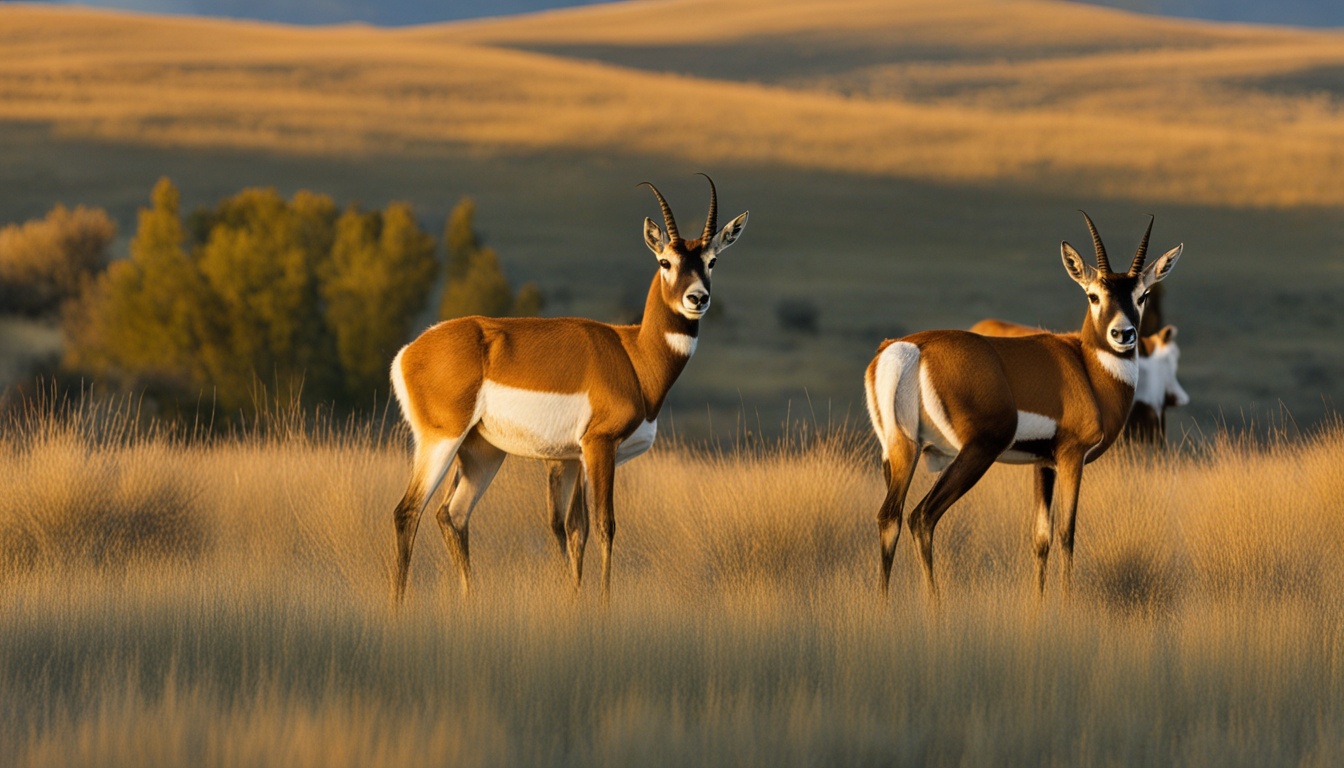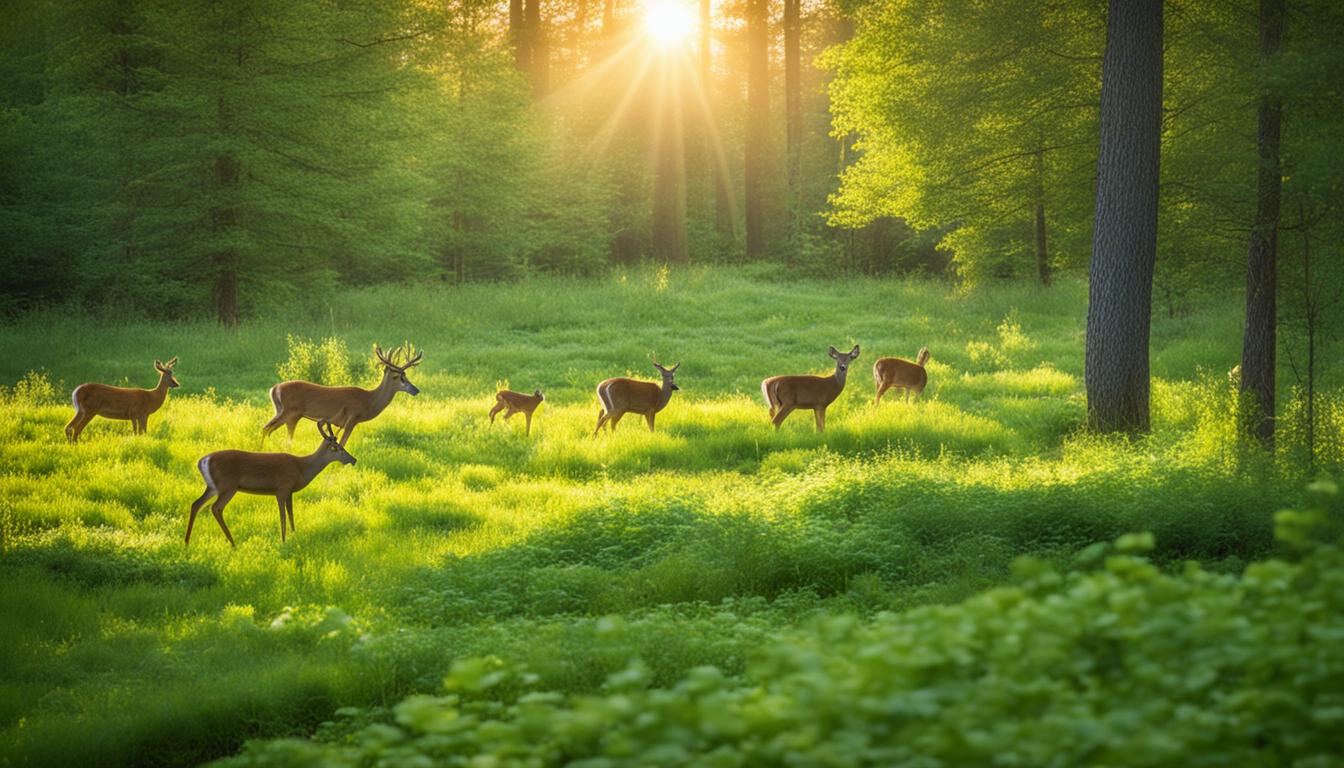Are you curious about the natural habitat of elephants? In this article, we will explore the fascinating world of elephant habitats and provide you with interesting facts about where these magnificent creatures can be found in the wild.
Elephants are incredible beings that can be found in various parts of the world. They have distinct habitat preferences depending on their species. Let’s delve into the details and discover more about elephant habitats and their natural environment.
Stay tuned for the following sections, where we will delve into the specific ranges and habitats of African and Asian elephants, the threats they face, the conservation efforts in place, and the vital role they play in their ecosystems. Get ready to explore the diverse and magnificent world of elephant habitats!
African Elephant: Range and Habitat
The African elephant, one of the majestic creatures found in the wild, is known for its vast range and diverse habitat preferences. These elephants can be found across the savannas of sub-Saharan Africa, the lush rainforests of Central and West Africa, and even the Sahel desert area of Mali. However, their habitat is under threat due to various factors, including deforestation and human encroachment.
To understand the range and habitat of African elephants in more detail, let’s explore the different species and their preferences. The African forest elephant, known for its smaller size and distinctive straighter tusks, thrives in dense rainforest habitats found in countries like Gabon, Cameroon, and Liberia. On the other hand, the African bush elephant, the larger and more widespread species, can roam across various landscapes, from grasslands to semi-desert areas in countries like Botswana, Kenya, and Zimbabwe.
Unfortunately, these magnificent creatures are facing habitat loss, primarily due to human activities. Deforestation for agriculture, infrastructure development, and logging are some of the key contributors to the destruction of their natural habitat. As a result, they face the risk of displacement and increased human-elephant conflicts. Conservation efforts are crucial to protect and preserve the habitats of African elephants, ensuring their survival for future generations.
African Elephant: Range and Habitat
| African Elephant Species | Range | Habitat Preferences |
|---|---|---|
| African Forest Elephant | Equatorial forests of Central and West Africa | Dense rainforest habitats |
| African Bush Elephant | Savannas of sub-Saharan Africa, Sahel desert area of Mali | Grasslands, semi-desert areas |
It is imperative that we take immediate action to protect the habitat of African elephants. By addressing the factors causing habitat loss and implementing conservation strategies, we can ensure that these incredible creatures have a safe and thriving environment to call home.
Asian Elephant: Range and Habitat
The Asian elephant, an iconic species native to South and Southeast Asia, occupies diverse habitats ranging from dense rainforests to scrublands. These majestic creatures are primarily found in countries like India, Sri Lanka, and Thailand, with India being the home to the majority of wild Asian elephants. To protect their habitat and ensure their survival, India has designated several elephant reserves spread across various forest areas.
Asian elephants have historically had a much larger range, but unfortunately, their habitat has significantly shrunk over the past centuries due to human activities. Deforestation, infrastructure development, and agricultural expansion have led to habitat loss and fragmentation, threatening the survival of this incredible species. As a result, the International Union for Conservation of Nature (IUCN) has listed Asian elephants as endangered.

Asian Elephant Habitat Requirements
Asian elephants have specific habitat requirements to meet their needs for feeding, foraging, and maintaining social structures. They require access to a variety of food sources, including grasses, leaves, fruits, and bark, as well as water for drinking and bathing. Additionally, they rely on dense vegetation and forest cover for shelter and protection.
Conservation efforts focused on preserving and restoring Asian elephant habitats are crucial for their long-term survival. By addressing the underlying causes of habitat loss, such as deforestation and human encroachment, and implementing sustainable land use practices, we can contribute to the conservation of these magnificent creatures and help ensure their continued existence in the wild.
Threats to Elephants Across Their Range
Elephants face numerous threats across their range, with habitat destruction being one of the most significant challenges. Human activities such as deforestation, infrastructure development, and agriculture encroach upon elephant habitats, leading to the destruction of their natural habitat. This not only disrupts their feeding and breeding patterns but also increases the risk of human-elephant conflicts. The loss of elephant habitat has severe consequences for their survival and the overall ecological balance of their ecosystems.
“The ongoing destruction of elephant habitats is a major concern for the conservation of these magnificent creatures. We need to urgently address this issue to ensure their long-term survival,” said Dr. Jane Parker, an environmental scientist.
In addition to habitat destruction, elephants also face threats from poaching for ivory. This illegal trade has devastating consequences, particularly for African elephants. Poaching not only reduces their population but also disrupts the social structure within elephant herds, leading to long-lasting effects on their overall well-being. Efforts to combat poaching and enforce stricter regulations against wildlife trafficking are critical to protecting elephants and their habitats.
Conservation efforts are vital in mitigating these threats and preserving elephant habitats. Various organizations and governments are actively engaged in elephant habitat conservation initiatives. These efforts include implementing protected areas, promoting sustainable land use practices, and engaging local communities in conservation activities. By addressing the underlying causes of habitat destruction and working towards sustainable coexistence with elephants, we can protect these majestic creatures and ensure the long-term survival of their habitats.
Habitat Requirements and Conservation
Understanding the specific requirements of elephant habitats is crucial for effective conservation. Elephants need vast areas to roam freely for feeding, foraging, and maintaining their social structures. This requires the preservation of large, intact habitats that can support the complex needs of these intelligent and social animals. By conserving elephant habitats, we not only safeguard the survival of elephants but also protect the countless other species that depend on these diverse ecosystems.
| Threat | Impact |
|---|---|
| Habitat Destruction | Disruption of feeding and breeding patterns, increased risk of human-elephant conflicts |
| Poaching | Reduction in population, disruption of social structure within herds |
Elephant Habitat Conservation Efforts
Protecting and preserving elephant habitats is a top priority for various organizations and governments worldwide. These dedicated conservation efforts aim to ensure the long-term survival and well-being of elephants in their natural habitats.
Conservation programs focus on a range of initiatives, including habitat protection, anti-poaching measures, sustainable land use practices, and mitigating human-elephant conflicts. These programs often collaborate with local communities to promote awareness and education, fostering a sense of shared responsibility for elephant conservation.
Research plays a crucial role in understanding elephant behavior and habitat requirements. By studying these majestic creatures, conservationists gain valuable insights that inform habitat conservation strategies and enable effective conservation planning.
One notable example of successful elephant habitat conservation is the establishment of designated elephant reserves in countries like India. These reserves provide protected areas where wild Asian elephants can thrive and continue to contribute to their native ecosystems. Through these efforts, steps are taken to prevent habitat destruction, restore degraded habitats, and create safe corridors for elephants to move between fragmented habitats.
Elephant Conservation Programs
In addition to habitat conservation, elephant conservation programs also play a vital role in ensuring the well-being and survival of these magnificent creatures. These programs focus on various aspects such as research, monitoring, and community engagement.
Research programs study elephant behavior, population dynamics, and genetics to gain a comprehensive understanding of elephants’ needs and the threats they face. This knowledge informs conservation strategies and helps monitor the effectiveness of conservation efforts.
Community engagement programs involve working closely with local communities to generate support and create incentives for coexistence with elephants. By involving local stakeholders, conservation efforts can address human-elephant conflicts and promote sustainable practices that benefit both people and elephants.
Overall, elephant habitat conservation and conservation programs are essential for preserving the world’s elephant populations. By safeguarding their habitats and engaging in comprehensive conservation efforts, we can secure a future where elephants continue to roam freely in their natural habitats, contributing to the ecological balance and biodiversity of our planet.
| Conservation Initiatives | Benefits |
|---|---|
| Habitat protection | Preserves natural habitats for elephants and other wildlife |
| Anti-poaching measures | Reduces the illegal hunting of elephants for their ivory |
| Sustainable land use practices | Promotes responsible land management to minimize habitat degradation |
| Human-elephant conflict mitigation | Reduces conflicts between humans and elephants through innovative solutions |
| Community engagement | Involves local communities in conservation efforts and promotes coexistence |
Elephant Facts and Ecological Importance
Elephants are truly remarkable creatures that not only captivate us with their size and appearance but also play a vital role in their ecosystems. As keystone species and ecosystem engineers, they have a profound impact on their habitats, shaping them through various ecological activities.
“Elephants are the gardeners of the forest, ” says Dr. Jane Goodall, renowned primatologist and conservationist.
One of the key ways elephants contribute to their habitat is through seed dispersal. As they roam across vast areas in search of food, they consume a wide variety of plants and fruits. The undigested seeds are later dispersed through their dung, facilitating the growth of trees and contributing to forest regeneration.
The Importance of Water Sources
In addition to seed dispersal, elephants also create vital water sources. With their strong tusks and powerful trunks, they dig water holes in dry riverbeds or use their feet to dig for water during times of drought. These water sources not only serve as a lifeline for elephants but also benefit other species in their habitat, ensuring their survival in challenging conditions.
Furthermore, elephants are skilled vegetation browsers, shaping the landscape by selectively feeding on certain plants. This behavior helps control vegetation density and promotes the growth of different plant species, ultimately enhancing biodiversity within their habitat.
| Ecosystem Role | Actions |
|---|---|
| Seed Dispersal | Elephants consume a variety of plants and spread seeds through their dung, promoting forest regeneration. |
| Water Source Creation | Elephants dig water holes during droughts, providing vital water sources for themselves and other species. |
| Vegetation Management | By selectively feeding on certain plants, elephants control vegetation density and enhance biodiversity within their habitat. |
It is clear that elephants have unique habitat requirements, demanding vast areas for feeding, foraging, and maintaining their social structures. Protecting their habitat is not only necessary for their own survival but also critical for maintaining the delicate balance and biodiversity in their ecosystems.
Conclusion
Understanding and conserving elephant habitats is essential for the long-term survival of these magnificent creatures. African and Asian elephants have distinct ranges and habitat preferences, but both face threats such as habitat loss, human-elephant conflict, and poaching.
Conservation efforts, including habitat conservation, anti-poaching measures, and addressing human-elephant conflicts, are critical for ensuring a future where elephants can thrive in their natural habitats. By valuing and protecting their habitats, we can contribute to the preservation of these iconic and endangered species.
By actively participating in elephant habitat conservation, you can help preserve the information about elephant habitats and ensure that future generations continue to marvel at these incredible animals in their natural environment. Together, we can make a difference in the conservation of elephant habitats and secure a brighter future for these majestic creatures.
How Many Species of Elephants Exist and Where Are They Found in the Wild?
There are three main species of elephants and their locations vary. The African elephant, found in sub-Saharan Africa, is the world’s largest land mammal. The Asian elephant is native to Southeast Asia, while the smaller African forest elephant inhabits the Congo Basin. Each species has its unique characteristics and plays a vital role in their respective ecosystems.
FAQ
Where can elephants be found in the wild?
African elephants can be found in sub-Saharan Africa, including savannas, rainforests, and the Sahel desert area of Mali. The African forest elephant is found in the equatorial forests of central and western Africa. Asian elephants are mainly found in the rain and scrub forests of South and Southeast Asia, including countries like India, Sri Lanka, and Thailand.
What is the range and habitat of African elephants?
African elephants can be found throughout the savannas of sub-Saharan Africa, the rainforests of Central and West Africa, and the Sahel desert area of Mali. The African forest elephant prefers dense rainforest habitats in countries like Gabon, Cameroon, and Liberia. The African bush elephant is more widely distributed, ranging from grasslands to semi-desert areas in countries like Botswana, Kenya, and Zimbabwe.
What is the range and habitat of Asian elephants?
Asian elephants are mainly found in the rain and scrub forests of South and Southeast Asia, including countries like India, Sri Lanka, and Thailand. The majority of wild Asian elephants are found in India, where they have designated elephant reserves spread across various forest areas.
What are the threats to elephants across their range?
Elephants face threats such as habitat loss, fragmentation, degradation, and human-elephant conflict. Human activities like deforestation, infrastructure development, and agriculture encroach upon elephant habitats, disrupting their feeding and breeding patterns and increasing the risk of conflicts. Poaching for ivory is another significant threat, particularly affecting African elephants.
What are the efforts being made for elephant habitat conservation?
Various organizations and governments are actively involved in elephant habitat conservation efforts. These initiatives focus on protecting and preserving elephant habitats, implementing anti-poaching measures, promoting sustainable land use practices, and mitigating human-elephant conflicts. Conservation programs often involve collaboration with local communities, education and awareness campaigns, and research to better understand elephant behavior and habitat requirements.
What is the ecological importance of elephants?
Elephants are considered keystone species and ecosystem engineers. They shape their habitats through seed dispersal, vegetation browsing, and creating water sources. They require vast areas to roam for feeding, foraging, and maintaining social structures. Conserving elephants is vital for their own survival and maintaining the ecological balance and biodiversity of their habitats.
Why is understanding and conserving elephant habitats important?
Understanding and conserving elephant habitats is essential for the long-term survival of these magnificent creatures. African and Asian elephants have distinct ranges and habitat preferences, but both face threats such as habitat loss, human-elephant conflict, and poaching. By valuing and protecting their habitats, we can contribute to the preservation of these iconic and endangered species.











